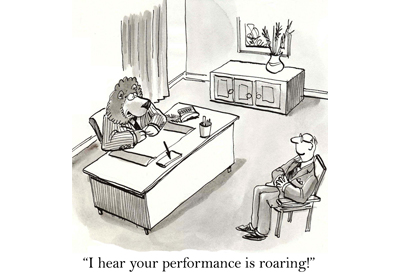Everybody’s invoking the word ‘accountability’ now that, following the global financial crisis, the lack of it has become so apparent. It’s a loaded word and a political football in sectors, such as health care and education, crying out for reform. Who should get what data about doctors’ success rates, hospital effectiveness, student achievement or school performance? What should be measured or tested, and what should be done with the data? Should bankers’ reimbursement be outcome-based, and what factors should be part of measurement? Should teachers be held accountable for the academic success or failure of their students?
In the best organisations, detailed performance metrics, benchmarks for comparison, and quantitative evaluations have become a way of life. But plenty of people still complain…
Why is ‘performance management’ so derided?
One reason we find performance ratings so threatening is that performance reviews are often done badly. They’re often robotic annual bureaucratic exercises to check off the boxes for salary purposes. In chronically poor-performing organisations, discussions about performance don’t mean you get coaching about constructive ways you could improve, and managers don’t engage peers in reviewing their performance data together to find solutions. You will often find managers are just as afraid to give feedback as staff are to receive it. In the worst scenarios, managers use data for blame rather than improvement, turning performance reviews into weapons of persecution; it’s no wonder that people want to hide. But that doesn’t help you or anyone else do a better job.
In contrast, you’ll find managers in high-performing organisations use information to help people improve, by giving them abundant, timely, and helpful data about their performance on a regular basis, individually and as a group. Here are some of the classic keys to ensuring that the whole process works to motivate people and improve their performance:
- Ask questions; stress inquiry. It helps to begin with agreement about goals and then to conduct an inquiry-oriented dialogue: did you do this, did you try that, and what happened? Questions help us deconstruct the details of our performance and consider alternatives without becoming defensive.
- Create humiliation-free zones. Performance metrics and reviews should not be used to “name and shame.” Provide a safe haven in which dialogue can take place without making anyone feel put on the spot, and where difficult issues can be discussed without assigning blame. The goal is to solve problems, not to hurl accusations or tear people down. Creating a positive climate calls for a matter-of-fact, objective manner: assume that people want to do the right thing and that the data will help them know what the right thing is.
- Break big goals into specific elements. Analysing the details that accumulate to produce either failure or success makes it easier to identify steps for improvement — and also allows people to feel proud of the things they already do well. The best reviewers pay attention to discrete actions rather than sweeping generalisations – this makes it easier to find strengths as well as weaknesses.
- Model accountability. You build others’ confidence in your leadership when you name problems that everyone knows are there, put performance data on the table for everyone to see, and refuse to shift responsibility to some nameless “them.” If you accept responsibility (for example, by sharing your own performance ratings), it helps others get over their fear of exposure and humiliation.
The tools of accountability – data, details, metrics, measurement, analyses, charts, tests, assessments, performance evaluations – are neutral. What matters is how you interpret them, how you use them, and the culture that surrounds them. In declining organisations, using these tools can signal that people are watched too closely, not trusted, about to be punished. In successful organisations, they are vital tools that high achievers use to understand and improve performance regularly and rapidly.
If you’re afraid of performance scrutiny, get over it! Transparency reigns. Facts and figures are increasingly easy to find, combine, and report. Discussions aimed at improving performance today can pave the way for a culture of ongoing feedback, review and truly outstanding performance in the future.
(Adapted from an article by Rosabeth Moss Kanter, with thanks.)
